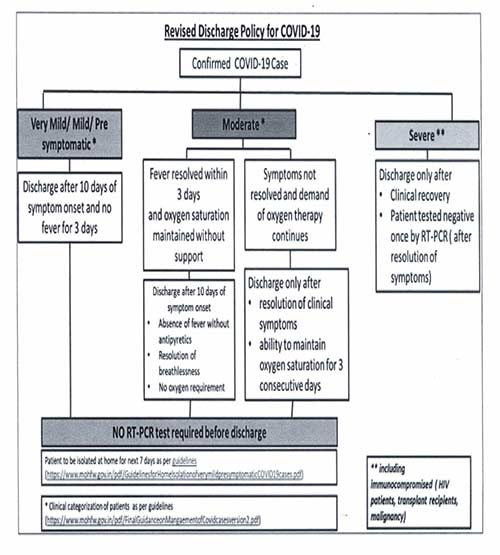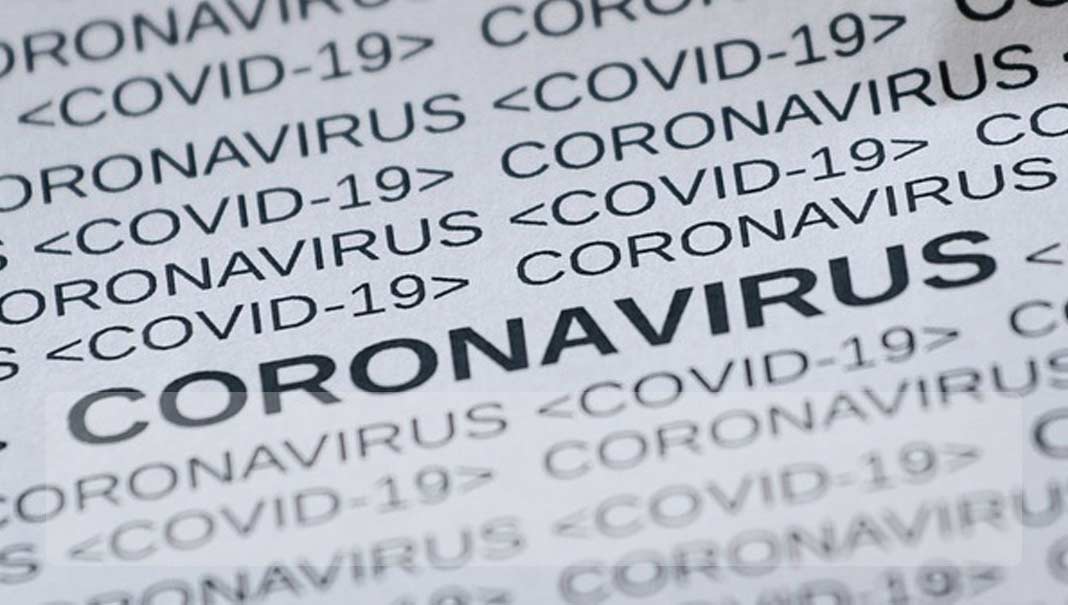Meghalaya | Revised Discharge Policy for COVID-19 patients

The Government of Meghalaya on Wednesday issued notification on the Revised Discharge Policy for COVID-19 patients.
The notification issued by Sampath Kumar, Commissioner & Secretary incharge Health & Family Welfare Department informed that in continuation of this Department’s Discharged Policy vide No.Health.94/2020/86, dated 27th August, 2020, the Revised Discharge Policy for patients admitted in Dedicated COVID-19 Hospitals and Corona Care Centres is hereby issued on the basis of the categorization of the patients in line with the Ministry of Health & Family Welfare’s guidelines on the categorization of patients based on clinical severity and their management in the 3 tier COVID facilities available at the website.
https://www.mohfw.gov.in/pdf/FinalGuidanceonMangaementofCovidcasesversion2.pdf
1. Mild/very mild/pre-symptomatic cases
Mild/very mild/pre-symptomatic cases admitted to a Corona Care Centre (CCC) will undergo regular temperature and pulse oximetry monitoring. The patient can be discharged after 10 days of symptom onset and no fever for 3 days. There will be no need for testing prior to discharge.
At the time of discharge, the patient will be advised to follow the home isolation for further 7 days as per guidelines at Annexure I.
At any point of time, prior to discharge from CCC, if the oxygen saturation dips below 95%, patient is moved to Dedicated COVID Hospital/Health Centre.
After discharge from the facility, if he/she again develops symptoms of fever, cough or breathing difficulty he will contact the COVID Care Centre or State helpline or 108. His/her health will again be followed up through tele-conference on 14th day.
2. Moderate cases admitted to Dedicated COVID Health Centre (Oxygen beds)
2.1. Patients whose symptoms resolve within 3 days and maintains saturation above 95% for the next 4 days
Cases clinically classified as “moderate cases” will undergo monitoring of body temperature and oxygen saturation. If the fever resolve within 3 days and the patient maintains saturation above 95% for the next 4 days (without oxygen support), such patient will be discharged after 10 days of symptom onset in case of:
- Absence of fever without antipyretics
- Resolution of breathlessness
- No oxygen requirement
There will be no need for testing prior to discharge.
At the time of discharge, the patient will be advised to follow the home isolation for 7 days as per guidelines.
2.2. Patient on Oxygenation whose fever does not resolve within 3 days and demand of oxygentherapy continues
Such patients will be discharged only after
- resolution of clinical symptoms
- ability to maintain oxygen saturation for 3 consecutive days
3. Severe Cases including immune-compromised (HIV patients, transplant recipients, malignancy)
Discharge criteria for severe cases will be based on
Clinical recovery
Patient tested negative once by RT-PCR (after resolution of symptoms).
Guidelines for Home Isolation of very mild/pre-symptomatic COVID-19 cases
1. Scope: All suspected (awaiting test results) and confirmed cases of COVID-19 disease are currently being isolated and managed in a hospital setting with the intent to break the chain of transmission. As per existing guidelines, during the containment phase the patients should be clinically assigned as very mild/mild, moderate or severe and accordingly admitted to (i) COVID Care Center, (ii) Dedicated COVID Health Center or (iii) Dedicated COVID Hospital respectively.
However, very mild/pre-symptomatic patients having the requisite facility at his/her residence for self-isolation will have the option for home isolation.
2. Eligibility for home isolation
- The person should be clinically assigned as a very mild case/ pre-symptomatic case by the treating medical officer.
- Such cases should have the requisite facility at their residence for self-isolation and also for quarantining the family contacts.
- A care giver should be available to provide care on 24 x7 basis. A communication link between the caregiver and hospital is a prerequisite for the entire duration of home isolation.
- Download Arogya Setu App on mobile (available at: https://www.mygov.in/aarogya-setu-app/) and it should remain active at all times (through Bluetooth and Wi-Fi)
- The patient shall agree to monitor his health and regularly inform his health status to the District Surveillance Officer for further follow up by the surveillance teams.
- The patient will fill in an undertaking on self-isolation (Annexure II) and shall follow home quarantine guidelines. Such individual shall be eligible for home isolation.
- In addition, the required instructions for the care giver and the patient as in Annexure III
shall be also followed.
3. When to seek medical attention: Patient / Care giver will keep monitoring their health.
Immediate medical attention must be sought if serious signs or symptoms develop. These could include (i) Difficulty in breathing, (ii) Persistent pain/pressure in the chest, (iii) Mental confusion or inability to arouse, (iv) Developing bluish discolorations of lips/face and (v) As advised by treating medical officer
4. When to discontinue home isolation: Patients under home isolation will end home isolation if symptoms are clinically resolved and the surveillance medical officer certifies him to be free of infection after laboratory testing.
Undertaking on self-isolation
I__________________________ S/W of ____________________________resident of __________________________ being diagnosed as a confirmed/suspect case of COVID-19, do hereby voluntarily undertake to maintain strict self-isolation at all times for the prescribed period. During this period I shall monitor my health and those around me and interact with the assigned surveillance team/with the call center (1075), in case I suffer from any deteriorating symptoms or any of my close family contacts develops any symptoms consistent with COVID-19.
I have been explained in detail about the precautions that I need to follow while I am under self-isolation.
I am liable to be acted on under the prescribed law for any non-adherence to self-isolation protocol.
Signature
Date
Contact Number
Instructions for care-givers
- Mask: The caregiver should wear a triple layer medical mask appropriately when in the same room with the ill person. Front portion of the mask should not be touched or handled during use. If the mask gets wet or dirty with secretions, it must be changed immediately. Discard the mask after use and perform hand hygiene after disposal of the mask.
- He/she should avoid touching own face, nose or mouth.
- Hand hygiene must be ensured following contact with ill person or his immediate environment.
- Hand hygiene should also be practiced before and after preparing food, before eating, after using the toilet, and whenever hands look dirty. Use soap and water for hand washing at least for 40 seconds. Alcohol-based hand rub can be used, if hands are not visibly soiled.
- After using soap and water, use of disposable paper towels to dry hands is desirable. If not available, use dedicated clean cloth towels and replace them when they become wet.
- Exposure to patient: Avoid direct contact with body fluids of the patient, particularly oral or respiratory secretions. Use disposable gloves while handling the patient. Perform hand hygiene before and after removing gloves.
- Avoid exposure to potentially contaminated items in his immediate environment (e.g. avoid sharing cigarettes, eating utensils, dishes, drinks, used towels or bed linen).
- Food must be provided to the patient in his room
- Utensils and dishes used by the patient should be cleaned with soap/detergent and water wearing gloves. The utensils and dishes may be re-used. Clean hands after taking off gloves or handling used items.
- Use triple layer medical mask and disposable gloves while cleaning or handling surfaces, clothing or linen used by the patient. Perform hand hygiene before and after removing gloves.
- The care giver will make sure that the patient follows the prescribed treatment.
- The care giver and all close contact will self-monitor their health with daily temperature monitoring and report promptly if they develop any symptom suggestive of COVID-19 (fever/cough/difficulty in breathing)Instructions for the patient
- Patient should at all times use triple layer medical mask. Discard mask after 8 hours of use or earlier if they become wet or visibly soiled.
- Mask should be discarded only after disinfecting it with 1% Sodium Hypo-chlorite.
- Patient must stay in the identified room and away from other people in home, especially elderlies and those with co-morbid conditions like hypertension, cardiovascular disease, renal disease etc.
- Patient must take rest and drink lot of fluids to maintain adequate hydration
- Follow respiratory etiquettes all the time.
- Hands must be washed often with soap and water for at least 40 seconds or clean with alcohol based sanitizer.
- Don’t share personal items with other people.
- Clean surfaces in the room that are touched often (tabletops, door knobs, handles, etc) with 1% hypochlorite solution.
- The patient must strictly follow the physician’s instructions and medication advice.
The patient will self-monitor his/her health with daily temperature monitoring and report promptly if develops any deterioration of symptom as detailed below


Leave a Reply